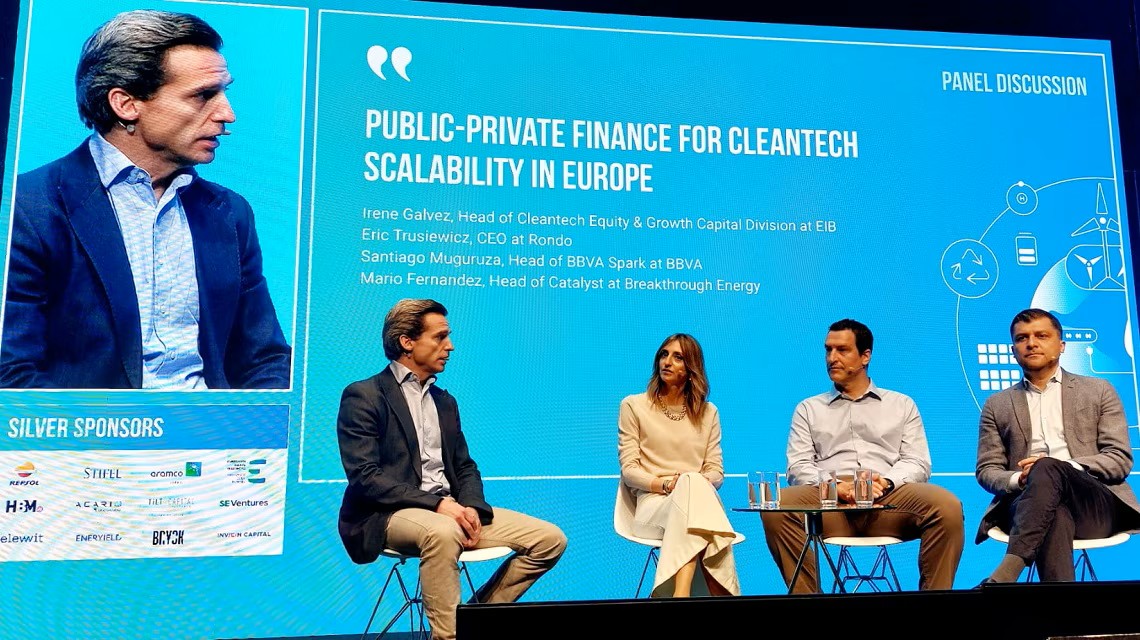AI omnipresent, mixed reality, and other disruptive technologies transforming businesses
Artificial Intelligence (AI) stands at the forefront of the most promising technologies, yet it is joined by others poised to revolutionize various sectors in the near future. These include advancements in combating climate change through innovations like heat pumps, geothermal systems, and highly efficient solar cells. Additionally, biotechnology showcases groundbreaking developments, notably the pioneering gene editing treatment. Meanwhile, computing is undergoing significant strides, particularly in the realm of ‘chiplets’ and exascale computers. Carlos Corominas, content director at Opinno and editor-in-chief of ‘MIT Technology Review in Spanish’, explained how these technological advancements are not merely shaping but profoundly altering the trajectory of our planet, our health, and our society, during the recent BBVA Spark Innovation Masterclass.
Artificial intelligence (AI), highly efficient solar cells, Apple Vision Pro, weight loss medications, improved geothermal systems, ‘chiplets’, the first gene editing treatment, exascale computers, heat pumps, and Twitter substitutes make up the list of the 10 breakthrough technologies of 2024 selected by ‘MIT Technology Review’, which annually highlights the most promising technologies across different fields.
“We firmly believe that technology is inseparable from the broader global context,” stated Carlos Corominas, content director at Opinno and editor-in-chief of ‘MIT Technology Review in Spanish’, during the ‘Innovation Masterclass: How to Use Disruptive Technologies for Your Business’ organized by BBVA Spark. Therefore, this year’s technologies reflect changes in the global context and respond to challenges such as geopolitical situations, climate change, and social aspirations. A list that companies must closely monitor due to its impact on businesses.
AI everywhere among disruptive technologies in 2024
AI holds a key place for both companies and users. When OpenAI launched the free web application ChatGPT in November 2022, no one expected what was coming. The application reached one million users just five days after its launch, laying the groundwork for a new era of disruption. “Although artificial intelligence was already being applied in many fields, the arrival of ChatGPT served for the general public to understand the possibilities of generative AI and to grasp the scope of the revolution underway,” emphasized Corominas.
Generative AI has sparked numerous debates: power struggles among tech giants, geopolitical interests, the need for regulation, redefinition of professions and work itself, as well as debates about the limits of art, what we consider creation, and even “what defines us as human beings,” said Corominas. Precisely the threat that AI may pose to humanity is a topic on which experts cannot seem to agree on. In March 2023, a group of 1,000 technology leaders, including Elon Musk, CEO of Tesla and SpaceX, joined to sign an open letter requesting a halt to the development of new artificial intelligences for six months to avoid their “profound risks to society.” Just four months later, another group of 1,300 experts signed a letter arguing that “AI is a force for good, not a threat to humanity.”
While these debates continue, the development of generative AI continues, with tech giants engaged in a race to achieve new breakthroughs. In this vein, OpenAI recently launched Sora, a generative AI for video creation that very realistically imitates the movement of objects, animals, and people.
Another example of content-generating AI is Lore Machine, which generates comics without the need for prompts. “Some predict the end of Hollywood and creators, while others point to a resurgence of ‘indie’ cinema due to the ability to create amazing things with few resources,” noted Corominas. “I lean towards the latter. If there’s anything more human than wanting to hear a good story, it’s the desire to tell one,” he opined.

The “fragile fascination” for Apple Vision Pro
Apple has aimed to make a breakthrough with its new Apple Vision Pro glasses, with the goal of driving widespread adoption of mixed reality. The education, healthcare, or logistics sectors are some that can benefit from them. However, according to renowned analyst Ming-Chi Kuo, Apple had to cut its production of the 800,000 Vision Pro glasses it had planned for this year to around 400,000 or 450,000 due to several issues. One of them is their high cost. This is compounded by the “six-month problem” of these types of devices, as described by New York Times journalist Kevin Roose, who states: “The initial novelty fades and small annoyances begin to accumulate, such as blurry graphics or lack of interesting applications. Invariably, six months after trying them out, every device ends up in my closet gathering dust.”
A recent Piper Sandler survey on youth trends indicates that 56% of those who own a virtual reality device hardly use it, and only 4% claim to use it daily. Devices like the Apple Vision Pro glasses fall victim to what Corominas calls “fragile fascination.” “I believe this applies to all these technological innovations that generate a high level of fascination when first tested, but that fascination does not last over time,” detailed the editor-in-chief of ‘MIT Technology Review in Spanish’.
Twitter Killers
At first glance, social networks may not seem like disruptive technology, but as Corominas stated, “recent history cannot be understood without social networks.” Facebook changed how we stay in touch with our friend networks, while X (formerly Twitter) transformed how we inform ourselves and participate in politics and civil society mobilizations: it played a fundamental role in the Arab Spring, the 15M movement in Spain, Occupy Wall Street, or, more recently, #MeToo or #BlackLivesMatter.

However, Elon Musk’s purchase of Twitter in 2022 and its transformation into X have caused changes in the social media landscape. “X is experiencing a trend shift in social media consumption driven by the predominance of Instagram and TikTok, which better engage with younger generations,” explained Corominas. In fact, a recent We Are Social study reveals that the preferred social network with the most active users in 2024 is Instagram (16.5% of the total), while TikTok has the highest average user time on Android of all social networks in the world: 34 hours per month, over an hour per day on the platform.
Heat pumps, geothermal systems, and solar cells for decarbonization
Among the emerging technologies to combat climate change, ‘MIT Technology Review’ highlighted heat pumps on its list this year, a technology that is already established but can contribute to the decarbonization of homes, buildings, and industry by running on electricity. Worldwide, heat pump sales grew by 11% in 2022 according to the International Energy Agency (IEA), while Europe experienced a significant 40% growth in heat pump installations, driven by the energy crisis and an effort to limit natural gas and avoid dependence on imports, especially from Russia. The potential impact of heat pumps on reducing emissions is significant, with projections suggesting a potential cut of 500 million tons in global emissions by 2030, equivalent to removing all cars from European roads.
Another disruptive technology selected by ‘MIT Technology Review’ is enhanced geothermal systems, which offer a promising solution for harnessing the abundant and consistent energy source provided by geothermal heat as an alternative to fossil fuels. Unlike solar or wind energy, geothermal energy remains constant regardless of weather conditions or time of day. However, it represents less than 1% of the global capacity of renewable energies.
On the other hand, super efficient solar cells, which combine traditional silicon with next-generation perovskites (which absorb different wavelengths of light than silicon cells), are a disruptive technology in climate change. “This technology could raise the efficiency of solar panels to new heights,” summarizes Corominas. In May 2023, Oxford PV announced that it had achieved an efficiency of 28.6% in a commercial-sized perovskite tandem cell. In November, LONGi set a new world record with a 33.9% efficiency of solar cells.
Innovations in computing
In 2023, the National Natural Science Foundation of China announced its plan to fund between 17 and 30 ‘chiplet’-related research projects involving design, manufacturing, and packaging, among others. Therefore, among the top 10 emerging technologies of ‘MIT Technology Review’ are ‘chiplets’, which are essentially smaller and more specialized than conventional chips, designed for specific functions, and can be interconnected to form a cohesive system. This modular approach not only improves performance but also reduces manufacturing costs by minimizing defects.
Another highlighted disruptive technology in the computing field is exascale computers, supercomputers capable of performing quintillions of operations per second. The Frontier computer, unveiled in May 2022 at the Oak Ridge National Laboratory, marks the beginning of the exascale computing era: it can perform as many calculations in a second as 100,000 laptops. However, this advancement is accompanied by the challenge of energy footprint: Frontier consumes the energy that could power thousands of homes.

Disruptive advances in biotechnology
In addition to purely technological advancements and those related to climate change, innovations in biotechnology also mark a new era in medicine. Among them, the first gene editing treatment stands out, offering hope to patients with potentially fatal diseases such as sickle cell anemia. For years, researchers have explored the potential of CRISPR technology, which allows for the precise cutting of DNA to insert therapeutic genes or eliminate pathogenic sequences. In late 2023, Vertex achieved a historic milestone, becoming the first company to receive regulatory approval for its CRISPR-based treatment in both the UK and the US.
Weight loss medications mark another milestone in biotechnology by offering hope for combating obesity, a global problem affecting one-third of American adults. These medications, developed by pharmaceutical giants like Novo Nordisk and Eli Lilly, suppress appetite and promote weight loss. However, side effects such as nausea and diarrhea are common, and the long-term health effects remain uncertain.
“All these technologies are not just about making our lives easier but are shaping the future of our planet, our health, and our society,” concludes Corominas. “They remind us that endless possibilities exist when we harness the power of human ingenuity and collaboration.”



